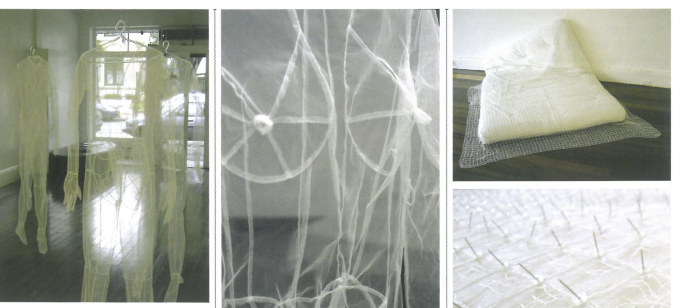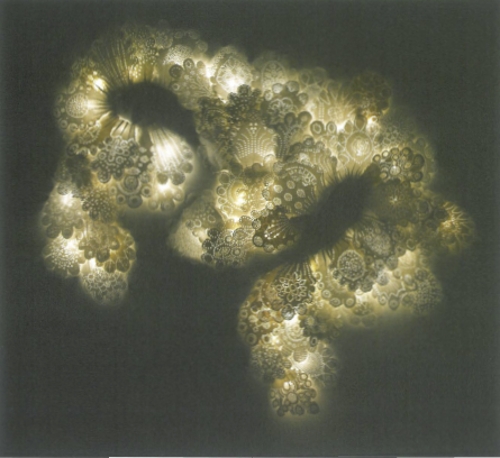
figures. Perimeter 2005 double bed blanket made from polyester thread and buttons, nickel plated pins, aprox 180 x 240 cm, all photos by Tracey Clement.
Tracey Clement has a long involvement with the body in all its incarnations. Years ago, when she was doing a Bachelor of Art Theory she persuaded her fellow students to adopt her images of the body transformed as the theme of their collective magazine Artwrite. She was no ordinary student as she was already well established as a jeweller. Her works in the Artist-Run Initiative, SafARI, part of the fringe of the Biennale of Sydney are jewellery, but not the pretty kind.
They are ragged and shrapnel-like, with red ribbons like blood. They twist their shape on bodies like pieces of shrapnel. The relationship between jewellery and wearer could be described as tough love.
On the other side of the city in Balmain a solo exhibition shows the other side of Clement. Border Zones seems at first to be an odd title.
Borders imply disconnection, a sense of edges rubbing against each other. But these are incredibly beautiful works. How can they speak of transgression, or 'crossing the line' in this context. But what we have here is a sense of what bodies might be, just parts of an identity which can be put on or discarded at will. But it is the visualisation of that conceit that is so successful. Her bodies hang on wire coat hangers like clothes. They are beautiful in their lightness and translucent quality as they appear to float in the air, like friendly spirits. The quality of light-filled air comes from the material they are made from, tulle, a fabric most commonly found in little girls' ballet dresses. The beauty of tulle is that it is woven as a net, and therefore will easily keep a shape. The pert breasts, neat bums and knobbly knees of these suits are more easily constructed because of the nature of this luminous fabric. At first the suits appear to be identical, bodies floating in the breeze, but some sport neat Peter Pan collars, a strangely prim addition in this context. The result therefore is of subtle difference masquerading as uniformity.
The other part of the exhibition, Perimeter, is a curious contrast. From a distance this appears so elegant and tranquil – delicate white tulle blanket, overlaid on a white mattress. This is the refined bed for those who have discarded their body suits. But on closer inspection this bed is defined by pins that prick through the fabric. Each pin is held in place by a tiny button which is hardly visible to the viewer, but as with the body suits, it is the details of construction that help control the grand vision. Instead of the bed being warm and welcoming, it is utterly uptight, a space for control freaks, or where inhibitions are reinforced rather than discarded. According to the exhibition blurb, Perimeter is a physical manifestation of the hazards of intimacy. If so, then Tracey Clement has certainly succeeded in visualising angst without any of the mess associated with that other bedroom girl, Tracy Emin.












